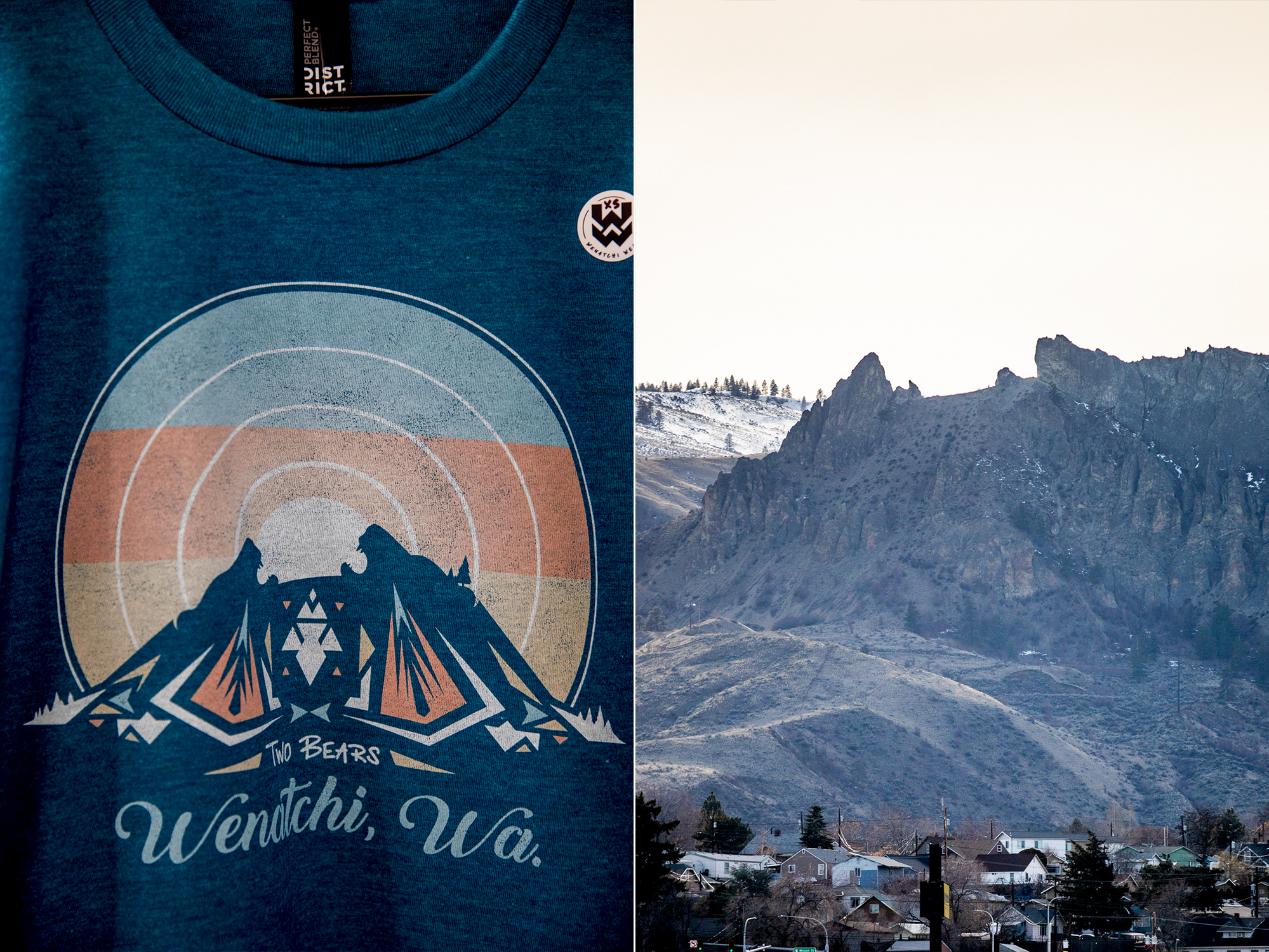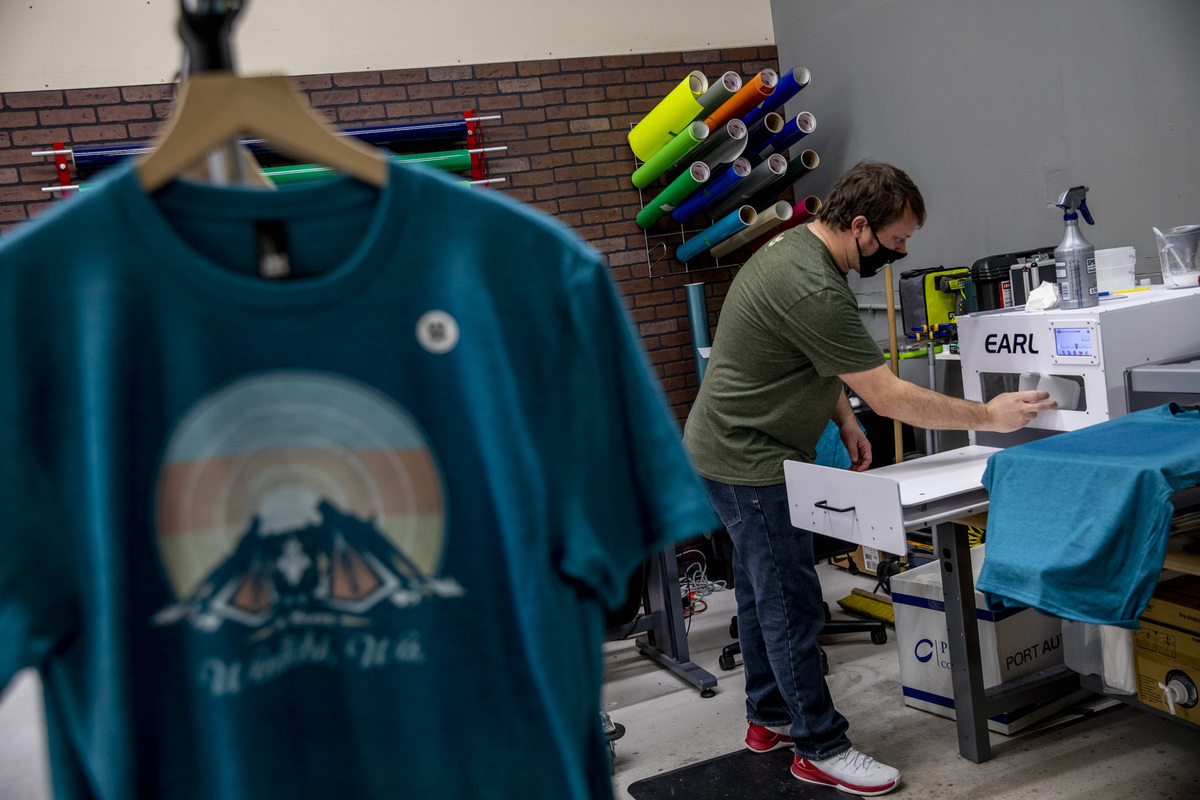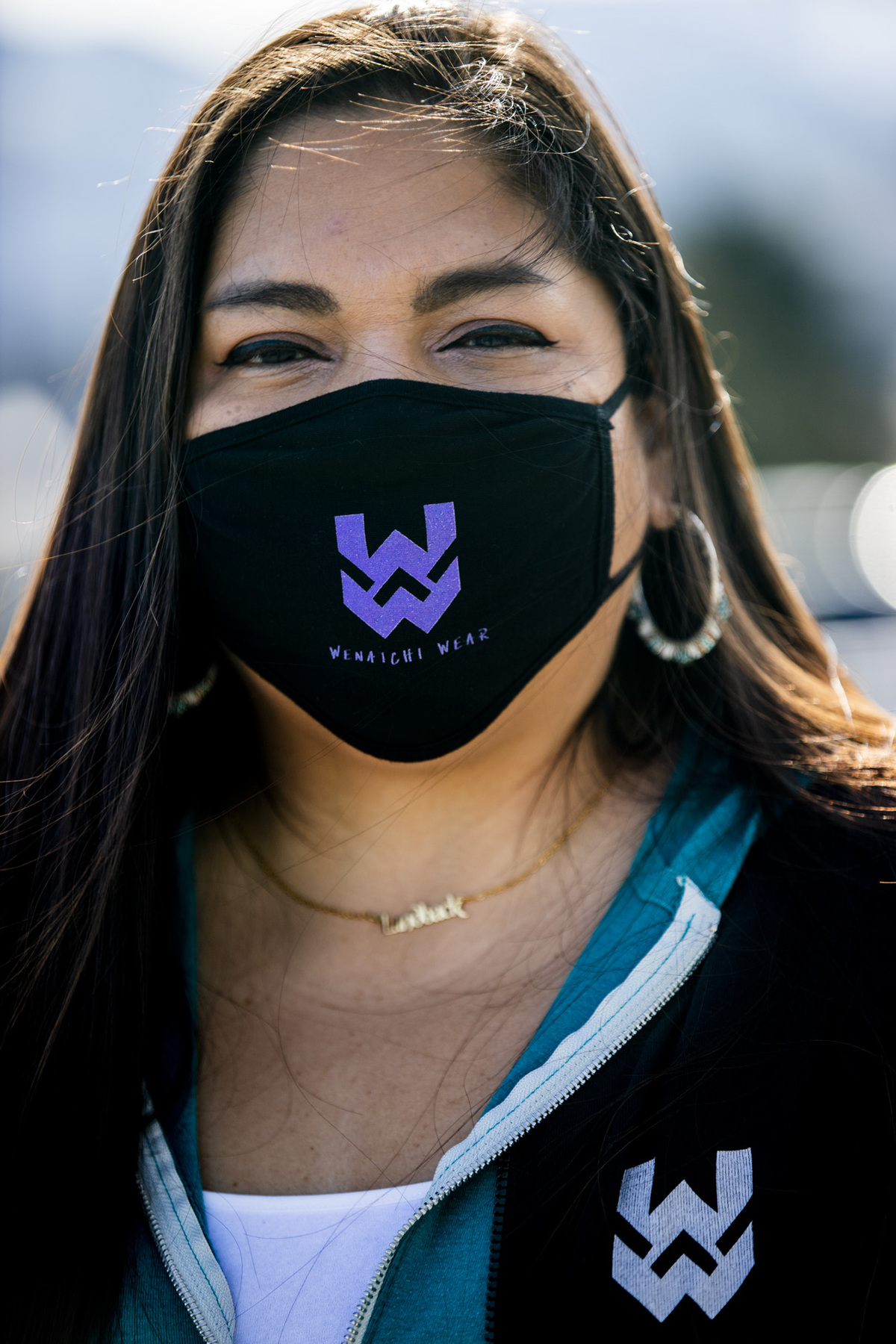Once you spot it, it’s impossible to miss: The craggy rock formations resemble the heads of two bears facing each other with mouths open, crying out toward the sky.
The iconic shape has inspired the fascination of many, and it’s central to a P’squosa story — the Native people whose ancestral lands lie along the Wenatchee River and who are frequently referred to by the exonym Wenatchi. The story goes like this: Two bears fought constantly until they were frozen in time as rocks by Coyote, a frequent trickster who had warned them that they needed to stop.
“So now they’re forever seen squaring off over the valley,” Big Bull-Lewis says.
She’s enrolled in the Confederated Tribes of the Colville Reservation and a member of its Wenatchi, Entiat and Moses bands, with Blackfeet ancestry as well. This story, one that she now knows well, has been passed down through generations of P’squosa people like herself.
But its original Two Bears name is overshadowed by another: Saddle Rock. This name is derived from the title once given to it by white settlers — one that originally included a Native slur that, after a protest, has since been removed from official documentation about the site. The settlers thought the twin peaks looked like a horse’s saddle. It’s the name now found all over hiking maps and descriptions of trails around the area.
Big Bull-Lewis wants to change that. After launching the Wenatchi Wear clothing line with her husband, Rob Lewis, in 2019, she designed a shirt with an illustration of Two Bears that became among the first the couple ever sold. Now, the two dream up designs together, researching ideas by talking to tribal elders and reading up on local history. She sells the shirt and others like it online and at a pop-up shop set up within the building of her other business, a design and print broker called R Digital Design.
“That’s kind of our motto — design with a purpose,” she says. “Being a Wenatchi tribal member, I was born and raised here in Wenatchee, and there’s a lack of Indigenous history that’s being taught — just at the grade level.”
As with all the designs in her clothing line, she wanted to use this one to educate the people in her community about the history of her tribe — which starts with its stories.
“This is a way of reaching more than just a single group of people — it can be a community education,” she says. “There’s not as many of us here on the homelands, but we need to change that conversation about talking about us in the past. We haven’t gone anywhere.”
All around her, Big Bull-Lewis sees similar stories of a Native history covered up by settler transfiguration. Her hometown itself, Wenatchee, takes its namesake from the Wenatchi people, tweaking only a few letters. Yet it’s not unusual for non-Native locals to have never heard of the Wenatchi people at all. Therein lies the problem: Their stories aren’t told.
“Speaking with people, they’ve asked if the Wenatchi tribe is extinct,” she says. “That’s disheartening to hear, but you can’t expect people to know if our schools and general public are not being taught.”
But Big Bull-Lewis and other people she’s rallied want more than awareness. In August 2020, she launched a Land Back fundraiser with a goal to purchase land in the area and build a community center where local Indigenous people can gather. Within months, they raised thousands of dollars — now just under $20,000, nearly reaching their goal of $25,000.
This, she says, is the way forward for Native people: ownership of land. The $25,000 is just the beginning; with a few others, Big Bull-Lewis is creating a nonprofit, with the Land Back Project as its working name, to continue these efforts.
“It’s always just been a hush-hush, we don’t bring it up or talk about how the land was stolen,” she says. “This is just bringing it to the front of everybody and saying, 'Hey, let’s do something about it.’ ”

The bucket list
The phrase “land back” has garnered increased attention online over the past few years, sparking conversation through its hashtag and generally becoming the shorthand reference for efforts directed at returning land to its original Indigeneous stewards. Some recent large-scale efforts, like protests last summer demanding the closure of Mount Rushmore and its area’s return to the land’s Native peoples, were a catalyst for widespread conversation.
Big Bull-Lewis says she has drawn inspiration from many of them, buoyed by their hope and potential.
“Maybe it’s just me being naive because I’m more involved right now, [but] I would say there’s been an uprising,” she says.
But she adds that the idea of fighting for the return of land itself is an old one. Native communities throughout the United States have a long history of land being taken through myriad methods, whether swiftly through outright theft and violence or slowly but surely through continued settler encroachment. The very signing of treaties between Native peoples and settlers established reservations for tribes that were much smaller than what they’d known as their ancestral lands. Even those provisions were later targeted by settlers who pressured Native people to leave them behind and assimilate into Euro-American society.
And as long as that has happened, there have been efforts to retain sovereignty over these lands and regain ownership. Some federally recognized tribes have leveraged their recognition into building a land base once more — like the Samish Nation, as one recent case. Other Native communities have invited residents living on their lands to pay “land taxes” or “rent” — funds that would then support their growth, like the Shummi Land Tax or Real Rent Duwamish.
In this particular case, the P’squosa are one of the many bands of Native peoples encompassed by the federally recognized Confederated Tribes of the Colville Reservation. While the band signed a treaty that promised a reservation, it wasn’t recognized, leading the P’squosa to eventually lose ownership of their land base entirely.
Randy Lewis, a P’squosa elder who’s a board member of the Land Back Project (no relation to Big Bull-Lewis), has ancestry connected to many of the bands encompassed by the Colville. He says that throughout his life, he’s seen many efforts to reclaim land — some that he was a part of himself, like the occupation that led to the creation of Daybreak Star in Seattle and the Alcatraz occupation of 1969. While the individual protests ended, those aspirations remained.
“We never stopped dreaming,” he says. “Generation after generation has petitioned the government to recognize our claim and our land holdings — so this isn’t something that’s new. It’s ongoing.”
Before Big Bull-Lewis began the project, Lewis already had his own plans in motion to make P’squosa history known. He’s worked with the Wenatchee Valley Museum and Cultural Center since 2018, leading tours of the area and telling participants about its Native history.
He led similar tours without the museum’s aid many years before that, starting in 2004 at the behest of his mother. Back then, news of his bus tours were spread primarily through word of mouth, drawing Native and non-Native people alike. This was all part of a quest that he inherited from his mother, who had inherited it from others before her.
“It was part of her bucket list, which was also part of my grandfather’s bucket list — that people become more educated and more aware of who we are, and that we’re still here, and that we have rights,” he says.
Lewis says the disregarding of P’squosa perspectives by the majority-white communities that settled in the area continues till this day. His grandfather and mother often reminded him of this, and the importance of exercising their rights to fish, hunt and gather in the area. If they didn’t, they warned him that those rights would also be pushed aside and forgotten.
“She used to tell me, ‘You’ve got to go down there, you’ve got to dig for bitter roots. You’ve got to dig for camas,’” he says. “Because if you don’t, white people will think it was always theirs, and they won’t allow you to do it.”
And so he did. With his family, Lewis says they’d harvest huckleberries and roots throughout the region, sometimes taking tribal elders out with them on these trips as well. In some cases, Lewis remembers reteaching elders about their traditions on these trips, as many had been separated from them.
“It was interesting, because our own people no longer remembered the culture because they had been generations removed,” he says. “All it takes is one generation removed for the history to be gone.”
The history of violence perpetrated by white settlers against the P’squosa people still stings in his family. They had witnessed it: When Lewis was a child, many of his elders experienced the massacres that accompanied conflicts like the Puget Sound War, which began in 1855. They watched P’squosa land succumb to development, without any consultation or concern for their connection to it. And they saw, too, the dispersal of P’squosa people away from their ancestral lands — many of whom were eventually forced to move onto the Colville Indian Reservation.
By the time Lewis was born, he says, his family members were among the last P’squosa people living in Wenatchee. They eventually moved to the Colville reservation, and Lewis would not return to live in Wenatchee again until 2018.
“When we left, there were no more Wenatchis living in Wenatchee,” he says.
And even then, cultural touchstones for the P’squosa and other Indigenous peoples of the region were still being violated by non-Native development. Lewis remembers witnessing one such instance in 1957, when he and his grandfather journeyed to Celilo Falls one last time to witness its inundation. Crowds of other Native people in the region had traveled to witness its destruction as well, standing beside Lewis as the flowing waters came to a halt. The falls, which had existed as a tribal fishing area for centuries, were silenced by the construction of The Dalles Dam.
“My grandfather told me, ‘Listen, you listen to that river, listen to those falls, because it’s not going to be here much longer,’” Lewis says, recalling those last moments before the water stopped. “And we listened as the water rose, and the sounds of the falls were extinguished.”

‘We need our own place’
Big Bull-Lewis turns to Lewis often when researching new designs for her clothing line. He was one of the first to tell her the story of Two Bears, with many more details than she had found in other tellings.
“I’ve learned more about that through Randy, and that [the two bears] are actually wives of another bear,” she says. “There’s always a little bit more to it.”
The two met a year before the launch of her fundraiser, and Lewis is now part of the growing advisory board for the effort. The board, Big Bull-Lewis says, will help in making concrete plans for the money raised — like the exact location of the land they’ll be purchasing, or what the community center will look like, both of which have yet to be decided.
For Native communities who don’t own land, gathering and making a community are infinitely more difficult. Cecile Hansen, chair of the Duwamish Tribe, says it was the case for her tribe for many, many years. With their ancestral lands in Seattle, it was often prohibitively difficult and expensive to puchase, so the tribe’s office moved from rental space to rental space.
“How can you gather in a small office?” Hansen says. “I mean, I rented about four places before I finally said we need to get our own place.”
A friend of Hansen later donated the two-thirds of an acre property that is now home to the Duwamish Longhouse and Cultural Center, which opened in 2009. It’s a place where tribal members can finally gather reliably, she says.
Since then, they’ve also started a fundraiser, Real Rent Duwamish, which allows people to “pay rent” to the tribe. Patrick Tefft, a Duwamish Tribal Services Board member, says the project has raised over $120,000 to date. The money, among other things, has allowed the longhouse to hire more staff and create an archival system for the tribe’s documents and artifacts.
“The vast majority of people give recurring gifts,” he says. “That’s really the strength of that. It’s created a sustainable source of funding.”
When Big Bull-Lewis explains her project to non-Native people, she explains it’s about returning it to its original Indigenous stewards, and giving them ownership of it.
“That's the whole goal,” she says. “It's been [hundreds of years] and for some reason, Indigenous peoples still don't have part of their homelands.”
It can be a difficult conversation. Sometimes, she says, people will respond by telling her that the wrongdoing of settlers happened a long time ago, and that it doesn’t affect them since they didn’t do it themselves. But Big Bull-Lewis reminds them: People living on Native land are still benefiting from their wrongdoings.
“There are many tribal members that are still hurting from that,” she says.
Planting seeds
Big Bull-Lewis didn’t grow up with P’squosa stories and traditions around her. Many of the stories that she’s now showcasing through her designs were ones she learned in the past few years through research and conversation with elders, like Lewis. Family members before her were frequently separated from their culture and traditions — some of that through residential schools, where many Native people were punished for practicing them.
“That’s another thing that people don’t understand. We don’t all know our culture or our race in that way, and it’s a product of our government and the way they’ve tried to erase us completely,” she says. “We have to find new ways to learn and educate.”
She’s working on that now with her 18-year-old son, Riley, who has been learning these stories alongside her. Inspired by her efforts, he advocated for the creation of a sign as part of an Eagle Scouts project that’s now set up along the Apple Capital Recreation Loop Trail in Wenatchee. The sign tells the story of Two Bears that passersby can read with the rock formation visible above.

Big Bull-Lewis is also reconnecting with her biological family with the help of Lewis, who knows many of them and even has old photos of relatives, like her grandmother.
“I didn’t know her,” Big Bull-Lewis says. Looking at the photos has astounded her: “She looks just like my mom.”
When Lewis returned to Wenatchee in 2018, there was a change — slight, but palpable. While many in Wenatchee remain largely ignorant of the history of the area, he says that there is, at least, more of an interest in learning it. He’s since begun working as an educator for a local school, Columbia Elementary, and teaches the interior Salish dialect spoken by the P’squosa to young children. Now, they often greet him on the street in his Native language.
“I hear kids screaming at me across the street using the language,” he says, laughing. Once, two of his students approached him in a grocery store, accompanied by their Mayan grandfather. Lewis was pleasantly surprised when their grandfather addressed him in his Native language as well, having been taught the words by the young students. “I haven’t heard our language with a Mayan accent, ever,” Lewis says.
That, he says, is the future. But he adds that this work will take generations, and requires patience of the people who are part of it. As a lifelong activist himself, one who had participated in the occupation that led to the creation of Daybreak Star, he’s seen efforts come and go. He’s acutely aware of the persistence they require.
“I’m getting to the point in my age where it’s kind of like planting — planting the seeds for the next generation,” he says. “I know it’s a lot of work.”
Big Bull-Lewis has seen glimpses of this change. In her store, at least, her customers call the rock formation she can see at her doorstep by its P’squosa name: Two Bears.
“They can’t see anything else now,” she says. “That’s just what it is.”



